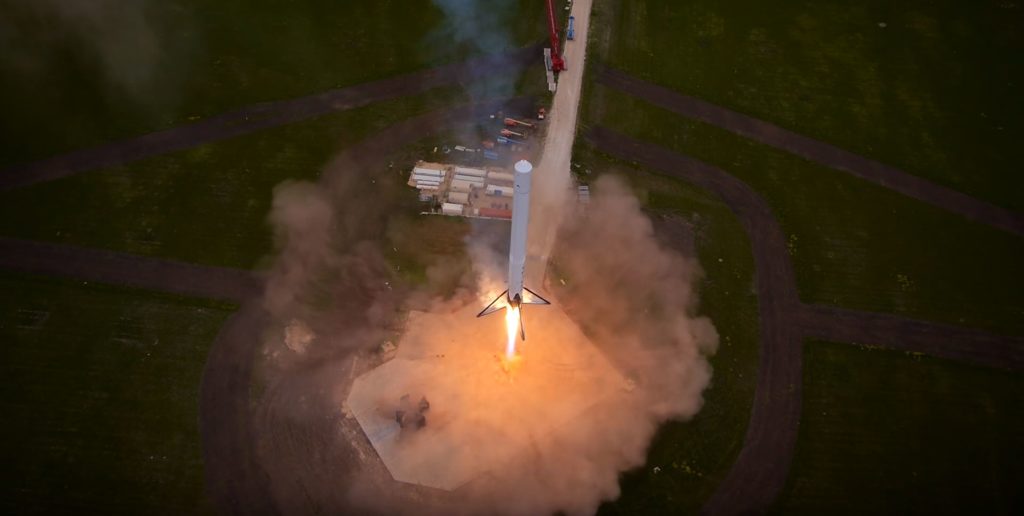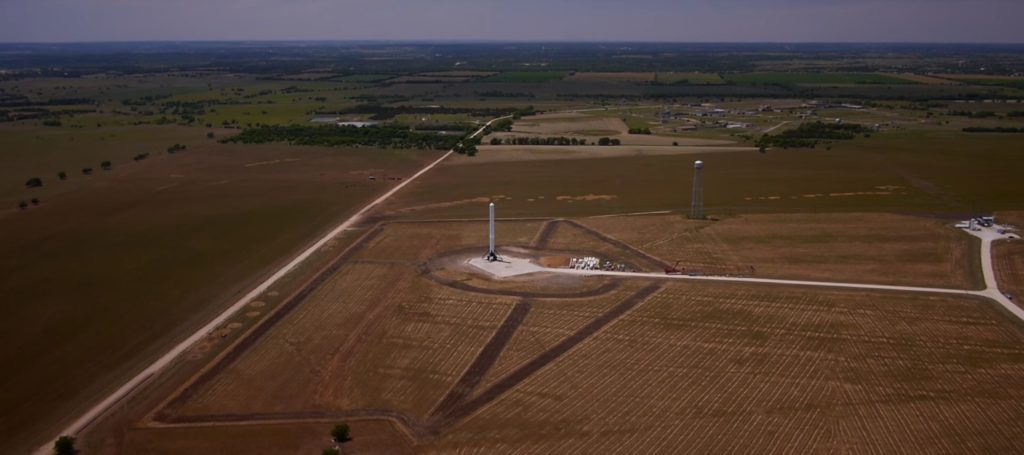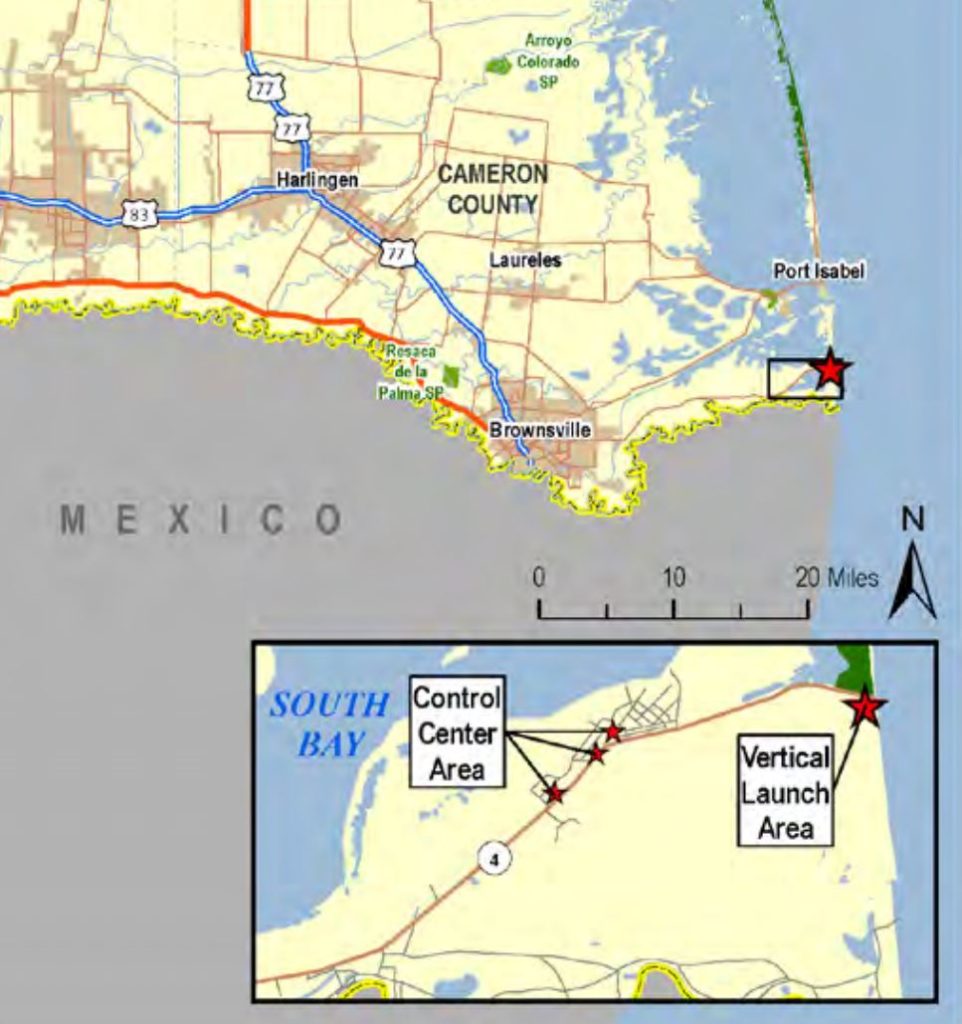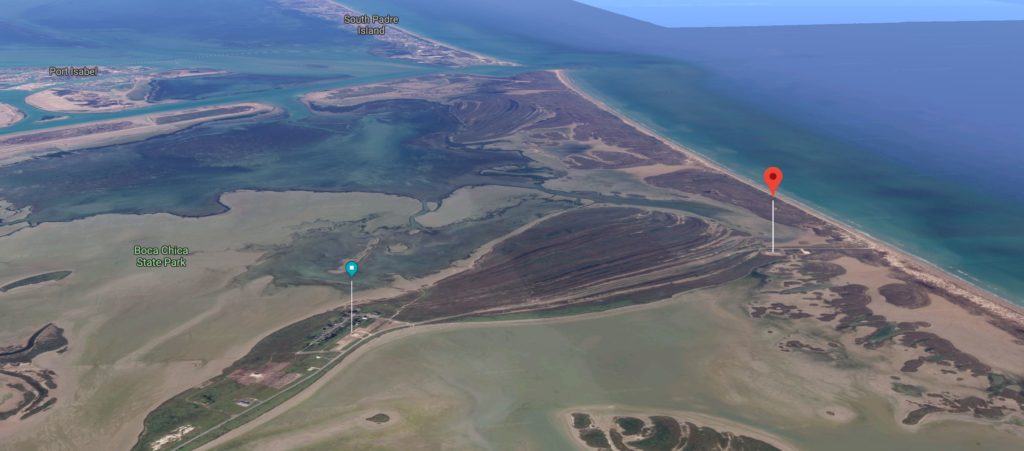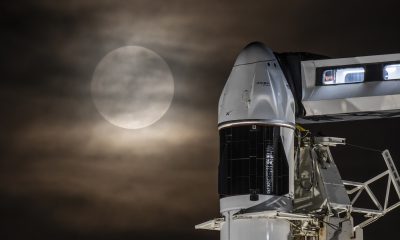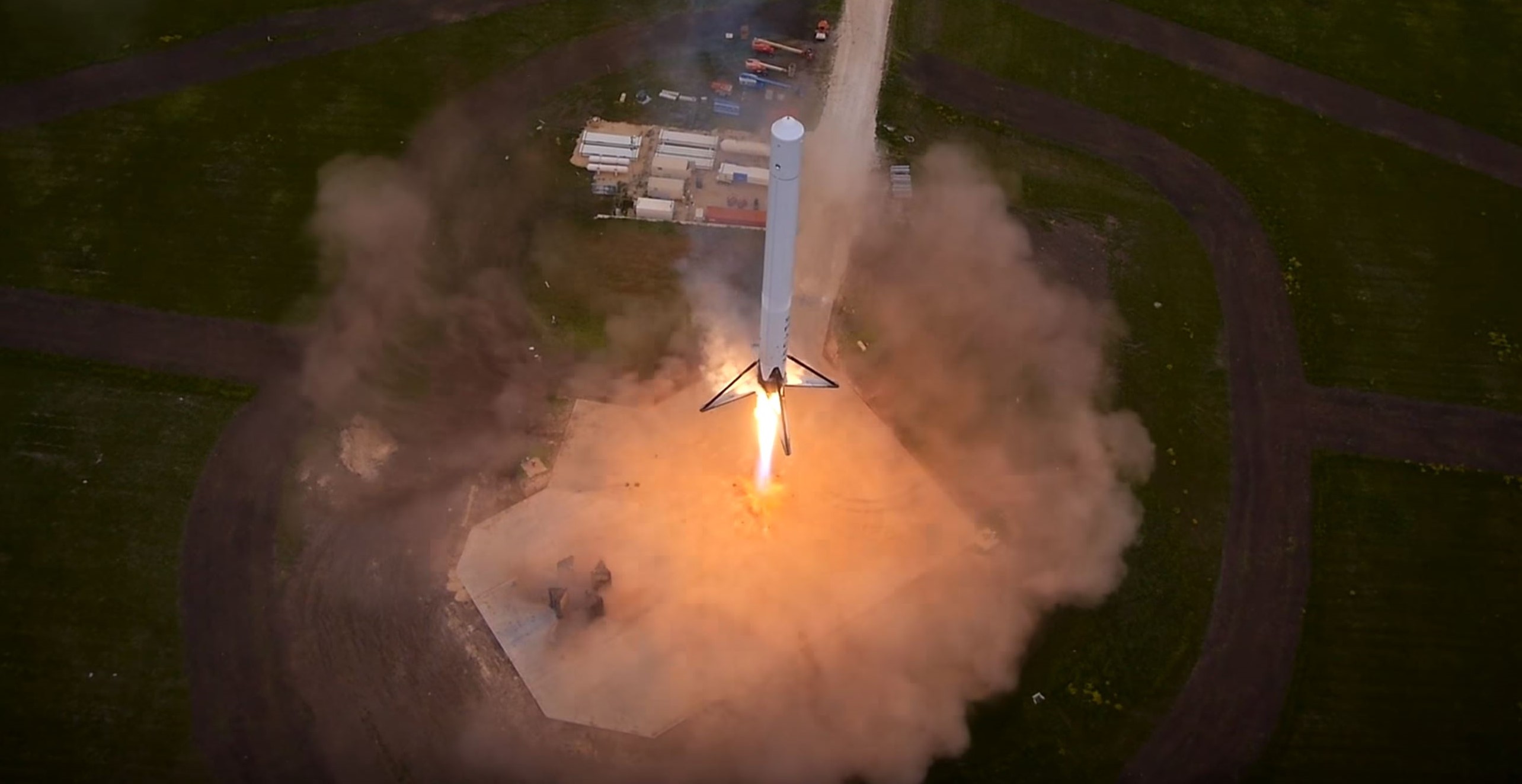

News
SpaceX begins huge dirt pile removal to pave way for BFR spaceship hop tests
After more than two years of silence, SpaceX has taken the first major tangible steps towards the construction of a dedicated South Texas rocket testing facility.
In anticipation of a full-scale BFR spaceship (BFS) hop test campaign that could begin as early as late 2019, local contractors and a smattering of SpaceX employees have begun to earnestly break down and repurpose a large quantity of dirt – known as a surcharge pile – to allow the construction of real facilities to begin.
Documented as of late by a handful of interested local observers and another subset of less local but equally interested followers, SpaceX’s prospective South Texas test and launch facilities have experienced a near-unprecedented burst of activity over the last two months, most notably including the arrival of a small fleet of heavy machinery and construction contractors at a site SpaceX has been working on for three years.
After ~36 months of dead silence, this activity correlates well with recent comments from SpaceX executives Elon Musk and Gwynne Shotwell indicating that the company is still targeting inaugural BFR spaceship hop tests sometime near the end of 2019.
Shotwell: think we’ll be “hopping” the second stage of BFR (the BFS) late next year. #DARPA60
— Jeff Foust (@jeff_foust) September 6, 2018
The infrastructure needed for those early tests could be quite sparse depending on the status of the BFR hardware to be ‘hopped’ – Falcon 9’s Grasshopper and F9R test campaigns, for example, operated off of a tiny concrete pad with extremely minimalist ground support equipment (GSE). Photos from a number of videos SpaceX posted during those crafts’ 2012-2014 series of hop tests demonstrate this minimum well, although chances are good that the company will build up Boca Chica a bit beyond the test pad used for Falcon 9 booster recovery R&D.
- F9R seen just before liftoff for a 2014 hop test at SpaceX’s McGregor, TX test facilities. (SpaceX)
- Just the bare necessities. (SpaceX)
SpaceX’s Grasshopper and F9R hop tests took place exclusively at the company’s well-established McGregor, Texas testing facilities, offering a range of large hangars, three operational Merlin 1D and Vacuum test bays, and dedicated stands for integrated first and second stage static-fire tests, among countless other rocketry-related amenities. The secluded South Texas coastal region where SpaceX wants to test – if not launch – integrated BFRs has none of McGregor’s preexisting infrastructure, however – anything SpaceX needs will have to be built from scratch on-site.
There is activity. pic.twitter.com/A8JYw6vdW6
— Nehkara (@Nehkara) October 13, 2018
Thus far, almost no real structures have been constructed, aside from a small-ish sheet metal shed that was literally built around a huge crane that arrived on SpaceX property a few months prior. Over the last two or so years, all activity at the South Texas site clustered specifically around a plot where two large radio dishes – and eventually cryogenic storage tanks – were delivered, installed, and/or stored. However, the actual site of the pad SpaceX originally planned to launch Falcon 9 and Heavy from is a mile or two East of that highly visible development, the same location where a flurry of activity has begun in the last month.
- A map showing several locations SpaceX planned (as of 2014) to develop.
- SpaceX’s proposed launch site (right) and the currently location of radar dishes, a large crane, and several propellant tanks. (Google)
In 2015, SpaceX trucked in several hundred thousand tons of dirt to be packed on top of the site where the company eventually planned to build a large Falcon integration hangar and then left for several years to crush the softer marshlands beneath it into firm submission. That time appears to be up, as the work now ongoing at that site is focused on removing that surcharging dirt now that the soil beneath it is stable enough to host heavy, long-term structures like a rocket launch pad.
Most of that massive dirt pile will likely remain at SpaceX’s South Texas property, to be used as a basic construction material as the company begins to build some semblance of the facility described in its approved 2014 environmental impact assessment. As it takes shape, it will become clear just how closely SpaceX is sticking to those original plans. BFR hop tests could begin by late 2019 if prototype spaceship construction – already in work at a tent in Port of Los Angeles – proceeds smoothly.
For prompt updates, on-the-ground perspectives, and unique glimpses of SpaceX’s rocket recovery fleet check out our brand new LaunchPad and LandingZone newsletters!
News
Tesla UK sales see 14% year-over-year rebound in June: SMMT data
The SMMT stated that Tesla sales grew 14% year-over-year to 7,719 units in June 2025.

Tesla’s sales in the United Kingdom rose in June, climbing 14% year-over-year to 7,719 units, as per data from the Society of Motor Manufacturers and Traders (SMMT). The spike in the company’s sales coincided with the first deliveries of the updated Model Y last month.
Model Y deliveries support Tesla’s UK recovery
Tesla’s June performance marked one of its strongest months in the UK so far this year, with new Model Y deliveries contributing significantly to the company’s momentum.
While the SMMT listed Tesla with 7,719 deliveries in June, independent data from New AutoMotive suggested that the electric vehicle maker registered 7,891 units during the month instead. However, year-to-date figures for Tesla remain 2% down compared to 2024, as per a report from Reuters.
While Tesla made a strong showing in June, rivals are also growing. Chinese automaker BYD saw UK sales rise nearly fourfold to 2,498 units, while Ford posted the highest EV growth among major automakers, with a more than fourfold increase in the first half of 2025.
Overall, the UK’s battery electric vehicle (BEV) demand surged 39% to to 47,354 units last month, helping push total new car sales in the UK to 191,316 units, up 6.7% from the same period in 2024.
EV adoption accelerates, but concerns linger
June marked the best month for UK car sales since 2019, though the SMMT cautioned that growth in the electric vehicle sector remains heavily dependent on discounting and support programs. Still, one in four new vehicle buyers in June chose a battery electric vehicle.
SMMT Chief Executive Mike Hawes noted that despite strong BEV demand, sales levels are still below regulatory targets. “Further growth in sales, and the sector will rely on increased and improved charging facilities to boost mainstream electric vehicle adoption,” Hawes stated.
Also taking effect this week was a new US-UK trade deal, which lowers tariffs on UK car exports to the United States from 27.5% to 10%. The agreement could benefit UK-based EV producers aiming to expand across the country.
News
Tesla Model 3 ranks as the safest new car in Europe for 2025, per Euro NCAP tests
Despite being on the market longer than many of its rivals, the Tesla Model 3 continues to set the bar for vehicle safety.

The Tesla Model 3 has been named the safest new car on sale in 2025, according to the latest results from the Euro NCAP. Among 20 newly tested vehicles, the Model 3 emerged at the top of the list, scoring an impressive 359 out of 400 possible points across all major safety categories.
Tesla Model 3’s safety systems
Despite being on the market longer than many of its rivals, the Tesla Model 3 continues to set the bar for vehicle safety. Under Euro NCAP’s stricter 2025 testing protocols, the electric sedan earned 90% for adult occupant protection, 93% for child occupant protection, 89% for pedestrian protection, and 87% for its Safety Assist systems.
The updated Model 3 received particular praise for its advanced driver assistance features, including Tesla’s autonomous emergency braking (AEB) system, which performed well across various test scenarios. Its Intelligent Speed Assistance and child presence detection system were cited as noteworthy features as well, as per a WhatCar report.
Other notable safety features include the Model 3’s pedestrian-friendly pop-up hood and robust crash protection for both front and side collisions. Euro NCAP also highlighted the Model 3’s ability to detect vulnerable road users during complex maneuvers, such as turning across oncoming traffic.
Euro NCAP’s Autopilot caution
While the Model 3’s safety scores were impressive across the board, Euro NCAP did raise concerns about driver expectations of Tesla’s Autopilot system. The organization warned that some owners may overestimate the system’s capabilities, potentially leading to misuse or inattention behind the wheel. Even so, the Model 3 remained the highest-scoring vehicle tested under Euro NCAP’s updated criteria this year.
The Euro NCAP’s concerns are also quite interesting because Tesla’s Full Self-Driving (FSD) Supervised, which is arguably the company’s most robust safety suite, is not allowed for public rollout in Europe yet. FSD Supervised would allow the Model 3 to navigate inner city streets with only minimal human supervision.
Other top scorers included the Volkswagen ID.7, Polestar 3, and Geely EX5, but none matched the Model 3’s total score or consistency across categories. A total of 14 out of 20 newly tested cars earned five stars, while several models, including the Kia EV3, MG ZS, and Renault 5, fell short of the top rating.
Elon Musk
Why Tesla’s Q3 could be one of its biggest quarters in history
Tesla could stand to benefit from the removal of the $7,500 EV tax credit at the end of Q3.

Tesla has gotten off to a slow start in 2025, as the first half of the year has not been one to remember from a delivery perspective.
However, Q3 could end up being one of the best the company has had in history, with the United States potentially being a major contributor to what might reverse a slow start to the year.
Earlier today, the United States’ House of Representatives officially passed President Trump’s “Big Beautiful Bill,” after it made its way through the Senate earlier this week. The bill will head to President Trump, as he looks to sign it before his July 4 deadline.
The Bill will effectively bring closure to the $7,500 EV tax credit, which will end on September 30, 2025. This means, over the next three months in the United States, those who are looking to buy an EV will have their last chance to take advantage of the credit. EVs will then be, for most people, $7,500 more expensive, in essence.
The tax credit is available to any single filer who makes under $150,000 per year, $225,000 a year to a head of household, and $300,000 to couples filing jointly.
Ending the tax credit was expected with the Trump administration, as his policies have leaned significantly toward reliance on fossil fuels, ending what he calls an “EV mandate.” He has used this phrase several times in disagreements with Tesla CEO Elon Musk.
Nevertheless, those who have been on the fence about buying a Tesla, or any EV, for that matter, will have some decisions to make in the next three months. While all companies will stand to benefit from this time crunch, Tesla could be the true winner because of its sheer volume.
If things are done correctly, meaning if Tesla can also offer incentives like 0% APR, special pricing on leasing or financing, or other advantages (like free Red, White, and Blue for a short period of time in celebration of Independence Day), it could see some real volume in sales this quarter.
You can now buy a Tesla in Red, White, and Blue for free until July 14 https://t.co/iAwhaRFOH0
— TESLARATI (@Teslarati) July 3, 2025
Tesla is just a shade under 721,000 deliveries for the year, so it’s on pace for roughly 1.4 million for 2025. This would be a decrease from the 1.8 million cars it delivered in each of the last two years. Traditionally, the second half of the year has produced Tesla’s strongest quarters. Its top three quarters in terms of deliveries are Q4 2024 with 495,570 vehicles, Q4 2023 with 484,507 vehicles, and Q3 2024 with 462,890 vehicles.
-

 Elon Musk4 days ago
Elon Musk4 days agoTesla investors will be shocked by Jim Cramer’s latest assessment
-

 News1 week ago
News1 week agoTesla Robotaxi’s biggest challenge seems to be this one thing
-

 Elon Musk2 weeks ago
Elon Musk2 weeks agoFirst Look at Tesla’s Robotaxi App: features, design, and more
-

 News2 weeks ago
News2 weeks agoWatch Tesla’s first driverless public Robotaxi rides in Texas
-

 News2 weeks ago
News2 weeks agoSpaceX and Elon Musk share insights on Starship Ship 36’s RUD
-

 News1 week ago
News1 week agoWatch the first true Tesla Robotaxi intervention by safety monitor
-

 News2 weeks ago
News2 weeks agoTesla has started rolling out initial round of Robotaxi invites
-

 Elon Musk2 weeks ago
Elon Musk2 weeks agoTesla to launch in India in July with vehicles already arriving: report

